The agreement was only a first step - now the BLM needs to finish the job and put in place a new final management plan that incorporates the settlement's protections and approach to responsible energy for the Roan . The BLM has issued its new Draft Environmental Impact Statement and is expected to make a final decision on the Roan in the next few months, so speaking out now can make a difference! Click here to sign our petition to BLM supporting a balanced approach that protects the Roan's unique cutthroat trout and outstanding big game habitat.
Proper Fish Handling Techniques
That 20" Rainbow you've been going for all day has just been netted. You hand the camera to a buddy, grab the trout out of the net and hold it up at eye level so the world can see the ear-to-ear grin. Upon reviewing the photo, you ask for another one- still holding the fish two feet above the water. The photo is finally good enough for Facebook so you place the fish into the river and let it hang in the water for a second before it regains strength and swims away awkwardly while high-fives are shared. The "Catch and Release" hashtag may tell everyone that the fish is back out there to be caught again, but the grip-n-grin picture shows an entirely different scenario.
That beautiful rainbow may have swam away. It's energy may seem like it was back to normal, but the fish is actually still in distress- and when trout are in distress, the chances of it dying are significantly increased.
The Fight
It all starts when the hook is set and the fight begins. According to Dr. Andy Danylchuk, an associate professor of fish conservation at the University of Massachusetts Amherst, fish release sugar (glucose) into their blood to fuel muscle activity and fight when they are hooked. When the excess glucose levels are released, it causes a build up of lactate in the blood and can have long-lasting affects on muscle function. This is the same issue that occurs in humans when they suffer a cramp during exercise.
It's best practice to not play with the fish to the point of exhaustion. Do everything you can to land the fish as quickly as possible.
Air Exposure and Handling
Once the fish is landed, the stress doesn't end. In fact it could be increased due to prolonged air exposure and poor handling techniques.
Taking the fish out water essentially stops the trout's ability to breathe. Fish breathe air by taking water in through their mouth, over the gills and out through the gill flaps (the operculum). "Taking fish out of the water stops dissolved oxygen from getting into the blood via the gills. No, the gills are not adapted to capture oxygen from air," says Dr. Danylchuck. "We are forcing the fish to hold its breath after running a race."
Even if the fish is out of water for only a few seconds, harm could still be done through improper handling. When handling a fish, always wet your hands prior to any touching. Trout have a protective coating (a slime layer) that protects them from disease. Wet hands reduce the risk of rubbing too much of the slime layer off. Adversely, when touched with dry hands, the coating is likely to rub off the trout's skin onto yours- leaving them exposed to disease.
Reducing exposure and handling time can be aided by using barbless hooks, or simply crimping the barbs on current hooks. If the hook is too deep, "several studies have shown that it is much better to cut the line and leave the hook in place rather than trying to dig the hook out," says Dr. Danylchuck.
Overall, the best practice would be to remove the hook while the fish is in the water.
This isn't to say that taking a fish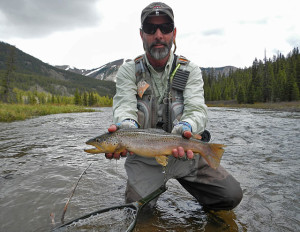 out of water will definitively kill the fish. There are tricks to minimizing air exposure and handling while still getting photo proof of your catch.
out of water will definitively kill the fish. There are tricks to minimizing air exposure and handling while still getting photo proof of your catch.
Allow the cameraman "to call the shots and get the angler to keep the fish in the water until the camera is ready," says Dr. Dalynchuck. Holding the fish only a few inches over the water will also help reduce air time. Regardless of the photo, however, the fish should be dripping wet (which makes the shot look even cooler). Underwater cameras make for a nice image as well.
Releasing
When it comes to releasing trout, it's not as simple as getting it back in the water and then it will be fine, (hopefully, 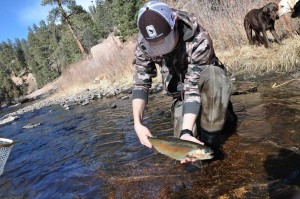 it doesn't need to leave the water). Even when the handling time is minimal, fish still need be released properly as well. When fish have experienced considerable physiological stress due to exercise and handling, they can lose their equilibrium, coordinated movements of their fins and roll or nosedive- resulting in death further on downstream.
it doesn't need to leave the water). Even when the handling time is minimal, fish still need be released properly as well. When fish have experienced considerable physiological stress due to exercise and handling, they can lose their equilibrium, coordinated movements of their fins and roll or nosedive- resulting in death further on downstream.
Good fundamentals in releasing, involve placing the fish in the water with it's head pointing into the current. Remember that the water needs to go through their mouth to exit the gill flap. Anglers should grip the fish lightly and look for coordinated fin movements to show that the fish has their equilibrium and can swim regularly own their own before letting the it go.
"Move a fish in a forward direction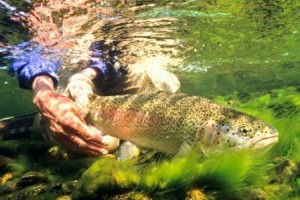 when helping it recover, do not move a fish back and forth—recall that water moving backwards over the gills does not help, but in fact, can actually harm the fish," says Dr. Danylchuck. "Let the fish go when its fins are showing coordinated movements, it can keep itself upright and it is actively trying to swim away from you."
when helping it recover, do not move a fish back and forth—recall that water moving backwards over the gills does not help, but in fact, can actually harm the fish," says Dr. Danylchuck. "Let the fish go when its fins are showing coordinated movements, it can keep itself upright and it is actively trying to swim away from you."
Remember that fish belong in the water and as responsible anglers it's up to us to help protect and keep them there. This includes, keeping the fight time minimal, reducing the trout's air exposure, keeping hands wet, and releasing the fish back into the water properly.
For more information on the affects of keeping fish wet, visit KeepEmWet.org or read Dr. Dalynchuck's Fundamentals of Fish report.
Behind the Fin: John Bocchino
- Name: John Bocchino
- Fly Fishing Guide for Rifle and Rise Outfitters in Gunnison
- Life time member of TU
- Web designer and communications for Gunnison Angling Society
- Best Quote from John: “I really wanted to contribute in any way I could to protecting our coldwater fisheries. We face constant challenges and I believe TU plays a major role in protecting what I love the most. I just want to do my part."
Member of the Gunnison Angling Society Chapter of TU, John Bocchino lives for fishing. His passion for fly fishing has led to the creation of a successful business, Rifle and Rise Outfitters. John has been a board member, vice president, and president of his chapter and currently works on the website and communications. The term Good Enough may fit nicely with his band name, but as a volunteer and member of TU, John is so much more than just "good enough."
- How long have you been a TU member?
I joined TU sometime in the 90s and then became a life member shortly after that. My business, Riffle and Rise Outfitters, is a registered TU endorsed business as well.
- Why did you become a member and what chapter are you involved with?
I joined TU and got involved because I wanted to try to make a difference with regard to coldwater conservation efforts. Fly Fishing is my passion, and I wanted to do my part to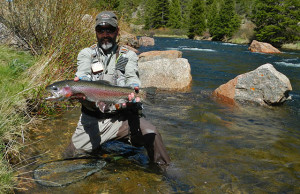 protect the resource. I was getting back into fly fishing in a big way while living in northern VA in the 90's. I became very involved at the state level in Virginia and helped with web development efforts and other projects for the VA Council of TU. In 2006, I moved to the Colorado Rockies for the mountains, rivers, and trout. I am an active member of our Gunnison Chapter of TU, the Gunnison Angling Society. I served on the Board, and was also VP and President. I built a new website for the chapter and continue to manage that, as well as chapter communications.
- What made you want to become more involved with TU?
protect the resource. I was getting back into fly fishing in a big way while living in northern VA in the 90's. I became very involved at the state level in Virginia and helped with web development efforts and other projects for the VA Council of TU. In 2006, I moved to the Colorado Rockies for the mountains, rivers, and trout. I am an active member of our Gunnison Chapter of TU, the Gunnison Angling Society. I served on the Board, and was also VP and President. I built a new website for the chapter and continue to manage that, as well as chapter communications.
- What made you want to become more involved with TU?
I really wanted to contribute in any way I could to protecting our coldwater fisheries. We face constant challenges and I believe TU plays a major role in protecting what I love the most. I just want to do my part.
- What is your favorite activity or project that you have done with TU?
I enjoy the web development work I’ve done for my local chapter, and I also enjoy helping to promote youth education as it relates to TU. I’ve been very involved in helping to raise funds and send kids to the CTU youth camp for several years now. I also recently managed two college interns from Western State Colorado University here in Gunnison, who worked for our chapter this past spring.
- What is a favorite fishing spot and favorite fishing story?
It’s tough to identify just one favorite spot for fishing. My favorite river here in Colorado is the Lake Fork of the Gunnison River. Between guiding and fishing, I probably spend about 150 days per year on the water. I remember my early days fishing the Catskills back in the 90s and early 2000s, where my friends and I would spend a week up on the Beaverkill and the West Branch during May, June, and September. We called it fish camp and really looked forward to those trips. I got into the hatches in a big way and started tying flies and calling out bug names in Latin while on the river. One day, one of my buddies came up to fish with us and he was just a beginner. He really didn’t fish much. Well, he proceeded to out-fish us in a major way and when I asked him what he was using, he said, “I don’t know. A big gray fuzzy thing.” So much for all the years of studying hatches and learning Latin.
 - To you, what is the best tactic or fly for catching trout?
The most important thing is patience.
That is the key word for fishing and definitely for guiding as well. You need to move slow, concentrate, and have a lot of patience and just
enjoy the ride. It’s not brain surgery. We’re just catching fish. I definitely don’t have just one top fly that I use. I enjoy dry fly fishing the most, and when I can’t do that, I love to streamer fish. So chasing big trout with a streamer is one of my favorite things to do. And for that, I like a size 4 Sculpzilla.
- To you, what is the best tactic or fly for catching trout?
The most important thing is patience.
That is the key word for fishing and definitely for guiding as well. You need to move slow, concentrate, and have a lot of patience and just
enjoy the ride. It’s not brain surgery. We’re just catching fish. I definitely don’t have just one top fly that I use. I enjoy dry fly fishing the most, and when I can’t do that, I love to streamer fish. So chasing big trout with a streamer is one of my favorite things to do. And for that, I like a size 4 Sculpzilla.
- Beyond being an awesome angler, what else do you do in your spare time or for work?
I have an outfitting business, Riffle and Rise Outfitters, which I set up last year so I could work for myself. This was my second season on my own and it was great. I like guiding for myself and having total control over what I do and how I can take care of my clients. When I’m not working/guiding or fishing, I enjoy playing music. I play guitars, dobro, and harmonicas, and I’ve been playing in a little band here for the past few months. I have a small recording studio in my house and we get together to record music every now and then. We’ve also performed live a few times this year. We’re not all that great and try not to take it too seriously, but we have a good time messing around with music. (I’m a fly fishing guide, not a rock star!) We go by the name Good Enough. I guess that says it all!
Dateline Durango: Animas after the spill
On August 5th, 2015, the Gold King mine near Silverton unleashed 3 million gallons of mine wastewater into the upper Animas River. Within hours, the plume had traveled downstream to Durango – right in the middle of a busy summer in a tourism-based town. The striking pictures of the orange plume spread across the globe in minutes. The media coverage was massive and the world took note. Lost among the “Orange River” pictures, the apocalyptic commentary with words like disaster, catastrophic, etc., and the hyperbolic ventilating about the impact to the fishery has been the good news: the Animas River has weathered the spill and the fishery through the Town of Durango is doing well.
 If you didn’t know to look for very faint traces of iron residue, you wouldn’t even know we had this insulting event in early August. The Animas is back to its usual state of water quality. As to the fishery, there has been no fish mortality documented from the spill, while bug sampling by an aquatic biologist with Mountain Studies Institute indicates a still thriving population of mayfly nymphs and caddis pupa. Colorado Parks and Wildlife (CPW) had installed pens of fingerling trout in the Animas before the plume arrived – a canary in a coal mine, if you will. None of those fish died either. In the past few weeks we have seen Baetis, midges and Tricos coming off. CPW ran an electro-shocking episode after the “Spill” with the usual re-capture protocol and got essentially the same results as the year before. Actually, the survey showed a slight improvement.
If you didn’t know to look for very faint traces of iron residue, you wouldn’t even know we had this insulting event in early August. The Animas is back to its usual state of water quality. As to the fishery, there has been no fish mortality documented from the spill, while bug sampling by an aquatic biologist with Mountain Studies Institute indicates a still thriving population of mayfly nymphs and caddis pupa. Colorado Parks and Wildlife (CPW) had installed pens of fingerling trout in the Animas before the plume arrived – a canary in a coal mine, if you will. None of those fish died either. In the past few weeks we have seen Baetis, midges and Tricos coming off. CPW ran an electro-shocking episode after the “Spill” with the usual re-capture protocol and got essentially the same results as the year before. Actually, the survey showed a slight improvement.
 While long-term effects of the spill are yet unknown, anglers, local fly shops and outfitters are breathing a sigh of relief that one of America’s great trout rivers has survived this ugly onslaught.
While long-term effects of the spill are yet unknown, anglers, local fly shops and outfitters are breathing a sigh of relief that one of America’s great trout rivers has survived this ugly onslaught.
This is not to diminish our concern for the Animas River and the fishery in the canyon below Silverton. This reach has been substantially impacted by three draining mines at the headwaters of Cement Creek, which flows into the Animas at Silverton. This, plus the recent “Spill”, highlights the very need for Good Samaritan Legislation for which TU is strongly advocating – so that abandoned mine cleanup projects can proceed here and elsewhere.
The bottom line is Durango is still a great place to visit and to be your base for fly-fishing outings.
- Buck Skillen, President, Five Rivers Chapter TU
The latest fishing report/forecast from Duranglers:
Except for some rain events the Animas has been fishing very well with solid Trico and midge hatches. Streamers have been effective as well. The Dolores River below McPhee Reservoir has suffered due to low flows the last few years but, with this past good water year, has been fishing much better. With forecasts for a good snowpack we are optimistic for the rebound to continue. Our high mountain streams will continue to fish for a bit but winter will come soon to the high country. The Piedra River and its tributaries are great options in the fall. The San Juan River below Navajo Dam has been fishing great this year. From now until at least Thanksgiving expect great midge and BWO hatches with some good dry fly fishing on the right day. And of course the San Juan is one of the best winter trout fisheries anywhere.
Tom Jones Honored at National Meeting
Colorado Trout Unlimited Southwest Regional VP, Tom Jones, was honored at the National TU annual meeting as the recipient of the Griffith Award for distinguished service in leadership. Jones is out of Durango and volunteers with the 5 Rivers chapter of Colorado TU where he works to raise awareness and protect amazing wild and native trout habitat in places like the Alpine Triangle.
"Serving as Chair of the New Initiatives work group for five years gave me the opportunity to see the extraordinary level of talent and passion that exists in TU, both staff and volunteers," said Jones. "To be selected for the Griffith Award by this exceptional organization is an honor that I will always cherish."
Jones also helped lead the effort in protecting the Hermosa Creek Wilderness. In December, Congress passed the The Hermosa Creek Watershed Protection Act, along with a handful of other public land bills, was attached as riders to the National Defense Authorization Act that protected Hermosa Creek wilderness area.
Tell Congress: Support Public Lands and Recreation
If Congress doesn't act this month, one of our nation's most successful public lands and recreation programs will come to an end. From the Great Sand Dunes, to access on the Colorado River, to community parks and trails in our own backyards, the Land and Water Conservation Fund (LWCF) has set aside and protected special places in Colorado and nationwide for the past 50 years.
A new Colorado TU report highlights the diverse benefits LWCF has provided to our state, from expanding hunting and angling access, to securing iconic landscapes like the Great Sand Dunes, to conserving private lands through conservation easements and partnerships. You can read the report here.
Yet this successful program is set to expire on September 30 if Congress doesn't act to extend it. Please ask your Senators and Representative - today - to support permanent reauthorization of LWCF and keep its benefits flowing to our public lands and our multi-billion-dollar outdoor recreation economy.
Click here to visit our online action alert where you can share your comments with your elected officials. Thank you!
TU Report: LWCF Benefits Colorado's Great Outdoors
In 1964, Congress created the Land and Water Conservation Fund (LWCF) to protect natural areas, water resources, and to provide recreation opportunities to all Americans. In its 50 year history, the LWCF has protected land in every state and helped support over 41,000 state and local parks. It has invested in public lands like Rocky Mountain National Park as well as supporting local community recreation resources and parks, cultural heritage sites, and working landscapes.Yet the authorization for this successful program expires on September 30, 2015 - and Congress has not yet acted to extend it. On July 30, the Senate Energy and Natural Resources Committee voted to send a bipartisan energy bill to the full Senate, but it still awaits that Senate vote. (Click here to contact your representatives today and urge them to support the LWCF.)

In Colorado, 77 percent of people are in support of the LWCF, the highest of any state.
Colorado has received $239 million in funds that have helped protect many state treasures like the Great Sand Dunes, Ophir Valley and Mesa Verde National Park- where $8.8 million in funds assisted in adding over 10,000 acres to the park since the year 2000. In return, outdoor recreation generates roughly $34.5 billion annually for the state.
To provide funds for recreation, LWCF uses revenues that stem from offshore oil and gas companies. Over $900 million is paid in royalties every year by these energy companies. However, in 50 years the LWCF has only been fully funded once, with Congress typically diverting some of the funds to other purposes.
While the LWCF has been an undisputed success in protecting public lands and promoting outdoor recreation, the program remains little known to many in the general public. To help tell some of the LWCF's Colorado success stories, Colorado TU has issued a report: Colorado's Great Outdoors - The Land and Water Conservation Fund in Colorado (click to open the report as a PDF file). Some examples of LWCF benefits to Colorado highlighted in the report include:
Fishing access & flood recovery. In 1976 when the Big Thompson River was 19 feet above its normal level, lives, homes and businesses were all lost. In the aftermath of the flood, the county went to the LWCF for just over $1 million in funds that the state would then match. With the new funds the County acquired 80 key properties along the Big Thompson for parks and angling access - properties that were not redeveloped and, when the river flooded again in 2013, helped avert an estimated $16 million in property damages.
The Town of Lyons was in a similar circumstance when the floods of 2013 hit. On September 12, the St Vrain Creek was flowing at 19,500 cubic feet per second- normally averaging at 67 CFS in September. The devastating floods caused damages of roughly $50 million and wiped out 39 acres of major park facilities- the main source of revenue for the town. Funding from the LWCF will help rebuild and extend the St Vrain Corridor Trail that provides recreational access along the St Vrain Creek.
Protecting iconic landscapes. President Herbert Hoover designated the Great Sand Dunes a national monument in 1932, but it would take nearly 70 years for the land to be recognized as a national park following the acquisition of the Baca Ranch. The designation was a direct result of grassroots efforts by residents of the San Luis Valley who recognized the unique landscape and the need to preserve it. The Great Sand Dunes, Baca National Wildlife Refuge, and the adjacent public lands all have benefited from LWCF funds in the past including with the critical initial acquisition of the Baca Ranch for the creation of the national park and preserve. Furthermore, Great Sand Dunes, Baca NWR, and the surrounding public lands have inholdings throughout the area, making management sometimes difficult because of the noncontiguous land pattern. LWCF funds have been used in the past to acquire some of these inholdings, easing management headaches and preserving this unique landscape.
According to surveys, 81 percent of voters approve of new land protection funding. In Colorado, Senators Michael Bennett and Cory Gardner are in full support of reauthorizing the LWCF to protect natural landscapes across the country for years to come. Members of Colorado’s House delegation are split on the issue.
Please visit the Action Center and urge your elected officials to reauthorize the LWCF!
New Clean Water Rule
On June 17th, 2015 the Denver Post posted Colorado Trout Unlimited executive director David Nickum's, and Rocky Mountain Farmers Union president Kent Peppler's article that highlighted the new clean water rule from U.S. Army Corps of Engineers and the EPA. The new rule is not an expansion of the Clean Water Act, but rather a "clarification of Clean Water Act jurisdiction," to quote the article directly. The rule allows for the water fish use as their habitat, and Coloradans use for safe drinking water, to be protected. It also ensures the protection of streams and wetlands that are essential to Colorado's outdoor recreation economy. The full article can be found below.
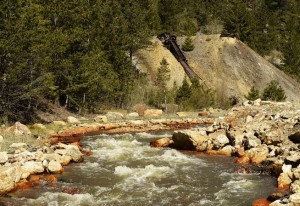
For nearly 15 years, 10,000 miles of streams and thousands of acres of wetlands in Colorado have been at greater risk of being polluted or destroyed due to confusion over what bodies of water are protected under the Clean Water Act. That all changed last week thanks to a new rule from the EPA and U.S. Army Corps of Engineers that restores protections to the vital waters that provide habitat for fish and wildlife and safe drinking water to two out of three Coloradans.
The rule is a clarification of Clean Water Act jurisdiction. It gives Colorado's farmers and ranchers a clear understanding of the rules that protect the water we rely on for the production of healthful food while maintaining all of the existing Clean Water Act exemptions for normal farming activities, and in some cases, strengthening them. The rule also gives Colorado sportsmen certainty that the wetlands and headwater streams that form the backbone of our state's $3 billion outdoor recreation economy will be safeguarded.
Contrary to what opponents have claimed, the rule does not expand the Clean Water Act. The rule does not protect any new types of waters or regulate ditches. It does not apply to groundwater, nor does it create any new permitting requirements for agriculture, or address land use or private property rights.
In crafting the long-overdue final rule, the agencies reviewed comments from more than 1 million Americans. Advocates on all sides had called for the clarification the rule provides, prompting the EPA and Army Corps to hold more than 400 meetings with stakeholders. The final rule is a clear victory not only for farmers, ranchers and sportsmen, but for all Coloradans. Unfortunately, it may not last long.
Before the clean water rule was even finalized, some members of Congress began to engage in last ditch efforts to block the anticipated rule, and restart the multi-year rulemaking process. Now that the rule has been written, these attacks have intensified. Inflammatory rhetoric about an administrative "power grab" are driving attempts to pass legislation in both the House and Senate that would force the agencies to go back to the drawing board and rewrite the rule. Not only would these efforts unnecessarily delay a process that has been well vetted from top to bottom, it would also have serious, damaging impacts on our water supply, our local farmers, sportsmen and our state's economy.
As Congress considers this unnecessary delay, Colorado's senators have a critical role to play. Sen. Michael Bennet has supported these efforts to protect clean water in the past, while Sen. Cory Gardner has been in opposition. We urge them both to do what's in the best interest for their constituents and oppose efforts to derail the clean water rule.
There is a misconception that all farmers oppose the clean water rule. In fact, farmers, ranchers and sportsmen have stood side by side for decades in the fight for clean water, and were present during the many public meetings and listening sessions the agencies held as they were forming the final rule. As we face down 11th-hour efforts to block the rule, we urge support for the clean water rule across the Continental Divide, from headwater trout streams to farm fields, to sustain our Colorado way of life for us and future generations of farmers, hunters and anglers.
A Renewed Push for Good Samaritan Legislation
Historically, mining played a large role in settling the American West and building the nation. However, its legacy – more than 500,000 abandoned hard rock mines with an estimated cleanup cost ranging from $36-72 billion – has persisted for the better part of a century with little progress toward a solution. According to the Environmental Protection Agency (EPA), abandoned hard rock mines affect 40 percent of headwaters in the western United States. Unfortunately, burdensome liability for would-be ‘Good Samaritans’, such as Trout Unlimited, has hindered abandoned hard rock mine cleanups. Good Samaritans didn’t create the problem, but they want to fix it. One needs to look no further than Colorado’s San Juan Mountains for acute examples of this problem. The San Juans are some of the most heavily mineralized mountains in the world, and they’ve been mined to death. More accurately, several fabled trout rivers in the region have suffered a long, slow death from acid mine drainage. The Animas River is completely devoid of aquatic life for many miles below Silverton on its way to Durango. Only through the input of clean tributaries does the water become diluted enough to support a strong fishery in Durango. The Uncompahgre River near Ouray is dead until the heavy metals fall out into the depths of Ridgway Reservoir. Other regional rivers, such as the Rio Grande and Lake Fork of the Gunnison, suffer as well.
Our tried and true pollution cleanup laws, the Clean Water Act and Comprehensive Environmental Response, Compensation, and Liability Act (better known as “CERCLA” or “Superfund”), place the burden of cleanup squarely on the owners of the property. Generally this is an excellent policy for most forms of pollution. But in the West, where the parties responsible for developing most of the old mine sites are long-gone, cleaning up these sites is a legal quagmire. A 2007 EPA policy memorandum provided useful protection to Good Samaritans from Superfund liability, but Clean Water Act liability remains a significant obstacle.
There are many projects in Colorado’s San Juan Mountains where water quality could be improved by collecting run-off, or taking an existing discrete discharge, and running the water through either an active or passive treatment system. Clean Water Act (CWA) compliance and liability issues remain a barrier to such projects.
In short, Good Samaritan projects need some sort of permit mechanism, such as that contemplated by legislation previously introduced by Senator Mark Udall and Rep. Scott Tipton in 2013. That legislation required a project to produce significant improvements in water quality for a specific period of time, implement best design and management practices, and conduct appropriate monitoring, but not expose the Good Samaritan to liability if the project at some point fails to achieve a required criterion for a given pollutant.
For over two decades numerous federal legislators have attempted to pass ‘Good Samaritan’ legislation with no success. Thankfully, Colorado’s Senator Michael Bennet and Colorado 3rd District Representative Scott Tipton are committed to resolving the problem. Building on their success with Trout Unlimited last year with the Hermosa Creek legislation, theses delegates are drafting site-specific Good Samaritan legislation for the San Juan Mountains. The hope is to demonstrate with pilot legislation that these types of projects can be successful, whereby removing political concerns for a national bill down the road.
Trout Unlimited will be coordinating the on-the-ground effort to educate communities and stakeholders while gathering supporters. We are building a grassroots coalition and you’re urged to voice your support. Visit the campaign website at: www.sanjuancleanwater.org. Click on the ‘Take Action’ tab to sign up. Find us on Facebook as well at San Juan Clean Water Coalition.
Let’s work together to pass this important legislation for healthy rivers and productive trout fisheries!
For info: Ty Churchwell – tchurchwell@tu.org 970-259-5116 x 11
Help determine future of Rio Grande National Forest
The Rio Grande National Forest has two public meeting scheduled for the week of June 22nd to discuss and gather public input for the Rio Grande National Forest’s plan revision. It would be very helpful if San Luis Valley Trout Unlimited could have chapter members present to represent us. Please plan to attend if you can! The first meeting will be on Monday, June 22, from 5:00 p.m. to 7:30 p.m. at the South Fork Community Building, 254 CO State Highway 149, South Fork. Participants at this meeting will help to identify current issues and foreseeable trends concerning management of fish, wildlife and rare plants on the RGNF.
The second meeting will be on Tuesday, June 23 from 5:00 p.m. to 7:30 p.m. at the Conejos Canyon Community Chapel. The chapel is located before mile post 20 on U.S. State Highway 17. Participants at this meeting will help to identify issues and impacts of recreation and its management on the RGNF and surrounding communities.
Both meetings will feature an open house for the first half hour allowing the opportunity to view maps and engage in one-on-one discussion with RGNF staff. A short presentation by forest service staff will begin at 5:30 p.m., followed by interactive discussions designed to provide input for the plan revision. Light refreshments will be provided.
The forest plan is the overarching document that guides all management decisions and activities on the entire Rio Grande National Forest, including preservation of cultural and historic resources, grazing, timber production, recreation, wildlife management, firewood cutting and gathering of special forest products.
For more information, visit the RGNF plan revision website at http://riograndeplanning.mindmixer.com/ or contact Mike Blakeman at the Rio Grande National Forest Supervisor’s Office at 719-852-5941 or Marcus Selig at mselig@nationalforests.org or 720.437.0290.












